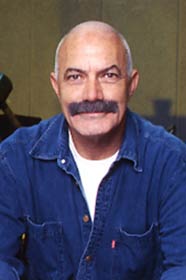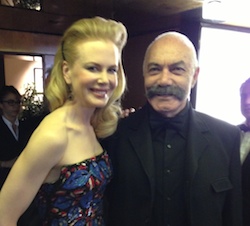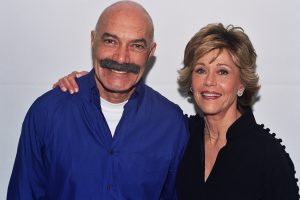Andrew Morton directed the colorful adventure, The Wild North, starring macho actor Stewart Granger, character actor Wendell Corey, and MGM dancer Cyd Charisse, this time around in a dramatic role as the nameless “Indian Girl.”
Grade: B- (**1/2* out of *****)

Theatrical film poster
|
|
The film is aka The Big North, Constable Pedley, The Constable Pedley Story, The Wild North Country and North Country.
It was the first movie shot in Ansco Color process (see below).
Granger plays Jules Vincent, a French-Canadian trapper who, while in northern Canadian town, helps an attractive Indian singer (Cyd Charisse) fend off unwanted attentions of drunken Max Brody (Howard Petrie).
Vincent sets off by canoe into the Canadian wilderness, taking the Indian girl up north to her tribe, accompanied by contrite Brody.
When the group arrives at her Chippewa village, Vincent tells the chief (John War Eagle), after Brody had acted recklessly on the rapids that he wanted to send him a warning, shooting into the air but accidentally killing Brody when the canoe pitched wildly.
Frightened, Vincent heads into the wilderness. After North-West Mounted Police Constable Pedley (Wendell Corey) arrives at the village, he learns about Brody’s death.
When she returns to the cabin, she finds Vincent still unable to break Pedley free from his fugue state. Vincent decides that the two men should travel the river and brave the rapids in an attempt to shake Pedley out of his condition.
The two men embark on a harrowing journey downriver in the canoe over treacherous rapids. Pedley finally begins speaking again, ordering Vincent to turn the canoe around, and when Vincent refuses, he tries to shoot him.
The canoe capsizes, and the two are thrown free, nearly drowning. As the bedraggled men drag themselves to shore along the bank of the river, Pedley thanks Vincent.
Spoiler Alert
At court hearing, Pedley testifies about the events, including the canoe trip, and the magistrate (Holmes Herbert) orders Vincent released.
As Vincent and the Indian girl depart, they give Pedley orange kitten and tell him to “build a house around it.” He names the kitten “Bebi,” and watches the couple head down the river in canoe, free.
The Wild North was known by the working titles, “Constable Pedley”, “The Wild North Country” and “North Country”.
The film was based on the true story of Mountie Constable Arthur Pedley, who in 1904 was assigned to find a lost missionary in northern Alberta. He managed to succeed despite great difficulty.
Location filming started in Idaho in March 1951. The shoot was then halted to enable Granger to make the film, The Light Touch (1951). Filming was scheduled to resume in July in Chipewyan, Alberta, Canada, where the actual events in Pedley’s story had taken place. However, due to inclement weather in Canada, the shoot was completed in the U.S.
The Wild North was shot in a new color process: John Arnold, MGM’s exec director of photography, and John Nicholaus, head of film laboratory, worked with Ansco for 10 years to develop it.
It had advantages of being able to be used in standard black and white cameras and processed in the studio laboratory with essentially the same facility as black and white film, making many time-saving steps in the handling, development and screening of daily rushes.
The film was particularly good for ‘day-for-night’ shooting, which was significant.
Bosley Crowther, critic for the N.Y. Times, wrote: “The picture is not of a consistent piece, either in narration nor photography. There are high points and dismally low points in its generally pulp-fiction tale of how an amiable French Canadian woodsman brings in a Mountie who was sent to bring him in.
“The high points are reached in a battle of the two men with wolves and in another recording their transit of a boiling rapids in a bobbing canoe. The low points are touched when they are struggling through the obvious studio snow.”
Commercial Appeal
A huge commercial hit, The Wild North earned about $2 million at the US box office in 1952. MGM records puts this figure at $2,111,000 with earnings of $1,896,000 elsewhere, leading to profit of $806,000.
In France, the film was extremely popular, recording 1,746,799 admissions.
Cast
Stewart Granger as Jules Vincent
Wendell Corey as Constable Pedley
Cyd Charisse as Indian Girl
Morgan Farley as Father Simon
J.M. Kerrigan as Callahan
Howard Petrie as Brody
Houseley Stevenson as Old Man
Lewis Martin as Sergeant
John War Eagle as Indian Chief
Ray Teal as Ruger
Clancy Cooper as Sloan
Credits:
Directed by Andrew Marton
Written by Frank Fenton
Produced by Stephen Ames
Cinematography Robert L. Surtees
Edited by John D. Dunning, George Boemler
Music by Bronislau Kaper
Production company: Metro-Goldwyn-Mayer
Distributed by Loew’s Inc.
Release date: March 28, 1952
Running time: 97 min.
Budget $1,282,000
Box office $4,007,000
Films Directed by Andrew Marton (1929-1967)
Two O’Clock in the Morning (1929)
The Night Without Pause (1931)
Johnny Steals Europe (1932)
North Pole, Ahoy (1934)
Demon of the Himalayas (1935)
Wolf’s Clothing (1936)
The Secret of Stamboul (1936)
School for Husbands (1937)
A Little Bit of Heaven (1940)
Gentle Annie (1944)
Gallant Bess (1946)
King Solomon’s Mines (1950)
Storm Over Tibet (1951)
The Wild North (1952)
Prisoner of War (1954)
Men of the Fighting Lady (1954)
Green Fire (1954)
Seven Wonders of the World (1956)
Underwater Warrior (1958)
Oh Islam (1961)
It Happened in Athens (1962)
The Longest Day (1962)
55 Days at Peking (1963, uncredited)
The Thin Red Line (1964)
Crack in the World (1965)
Clarence, the Cross-Eyed Lion (1965)
Around the World Under the Sea (1966)
Birds Do It (1966)
Africa Texas Style (1967)










